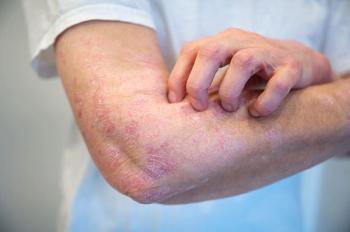
Schamberg's Disease
These orange-to-brown macules with red puncta, or cayenne pepper spots, are typical of Schamberg's disease (progressive pigmented purpuric dermatosis). The cause of this disorder is unknown, but it may be related to a cellular immune reaction or drug reaction.
These orange-to-brown macules with red puncta, or cayenne pepper spots, are typical of Schamberg's disease (progressive pigmented purpuric dermatosis). The cause of this disorder is unknown, but it may be related to a cellular immune reaction or drug reaction.
An asymptomatic purpura developed on the lower legs and feet of a 60-year-old man (A). When this picture was taken, the patient's international normalized ratio was 2.45. He was taking warfarin for chronic atrial fibrillation and nabumetone for osteoarthritis. It was thought that one or both of these medications contributed to this patient's disease.
A 31-year-old woman's nonpruritic purpura also involved both legs and feet (B), but it was not attributed to medication. Birth control pills were the only drugs she was taking. Laboratory findings, including complete blood cell count, platelet count, prothrombin time, and partial thromboplastin time, were normal, thereby ruling out a coagulopathy.
A biopsy of tissue from the affected areas of a 70-year-old man's legs (C) revealed perivascular lymphohistiocytic infiltrate of the epidermis with focal red blood cell extravasation. These findings confirmed the diagnosis of Schamberg's disease.
There are no hematologic disorders, venous insufficiencies, or internal diseases associated with Schamberg's disease. It occurs more often in men than in women, and children may be affected. The eruption may last months or years.
The purpura most commonly appears on the lower legs but may erupt on the upper body as well. Usually Schamberg's disease is asymptomatic, but mild pruritus and scaling may be present. The cayenne pepper spots apparently result from capillary leakage of hemosiderin.
Reassure patients that Schamberg's purpura is not associated with serious disease. Topical corticosteroids may be applied if itching is bothersome.
Newsletter
Enhance your clinical practice with the Patient Care newsletter, offering the latest evidence-based guidelines, diagnostic insights, and treatment strategies for primary care physicians.

















































































































































































































































































